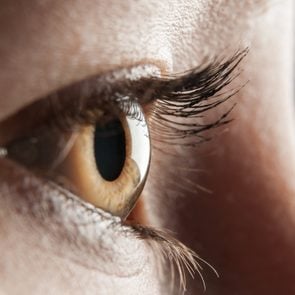9 Subtle Signs of a Dangerous Eye Infection
Updated: Jun. 30, 2022
Pain, redness, itching…find out how to tell if your eye infection is dangerous or just annoying.
If you have young children who’ve spent time in daycare or school, there’s a good chance you’re familiar with pink eye (aka conjunctivitis). This contagious eye inflammation is the most common type of eye infection. But at times it can be difficult to tell if the red, itchy, inflamed eye is something more serious.
“Most run-of-the-mill conjunctivitis turns the eye blushy pink and there’s tearing and goop,” says Michelle Andreoli, MD, a comprehensive ophthalmologist at the Wheaton Eye Clinic in Wheaton, Illinois, and clinical spokesperson for the American Academy of Ophthalmology. “But if you develop redness, sensitivity to light, vision change, and pain—what eye doctors call ‘RSVP’—you should see an ophthalmologist.”
While some infections like pink eye can resolve on their own, others can cause permanent damage and require immediate treatment. According to the Centers for Disease Control and Prevention (CDC), almost 1 million people seek treatment for an eye infection each year, mostly due to issues with contact lenses.
Here’s a look at some of the most common eye infections, what causes them, and how they’re treated.
Common eye infections
Conjunctivitis
This is inflammation or infection of the conjunctiva, the clear membrane that lines the eyelid. Most cases of pink eye are viral and resolve on their own. If the infection is bacterial, you’ll need antibiotic eye drops. Symptoms include eye redness, itching, burning, and discharge.
Blepharitis
An inflammation of the eyelids that causes crusting, burning, and dandruff-like flaking along the line of the lids. Characterized by redness, sensitivity to light, vision change, and pain (RSVP), “it’s treated easily by an ophthalmologist, but can’t be treated on your own,” says Dr. Andreoli. Blepharitis is often caused by a bacterial infection. (Find out if your itchy eyes are really a sign of eyelid dermatitis.)
Iritis
This refers to inflammation of the iris or colored part of your eye. It can be caused by a bacterial, viral, or fungal infection, as well as injuries and health problems like autoimmune diseases. “Iritis is characterized by RSVP and is typically something patients wouldn’t ignore for long because it’s rather uncomfortable,” says Dr. Andreoli. “If you ignore it for even a few days, it’ll get worse.” Symptoms also include headaches.
Keratitis
This is an infection of the cornea, the clear dome-shaped covering over your pupil and iris. Infectious keratitis can be caused by bacteria, viruses, parasites, and fungi. It’s often triggered by contaminated contacted lenses. Yet another infection characterized by RSVP, it can cause permanent vision damage if left untreated.
Endophthalmitis
An infection of the tissues or fluids inside the eyeball. It usually develops rapidly, but can also develop slowly and persist for long periods of time. Characterized by RSVP, it shouldn’t be ignored, says Dr. Andreoli. Considered an emergency medical condition, endophthalmitis usually requires prompt attention to avoid vision loss.
How do eye infections form?
Wearing contaminated contact lenses is a common cause of eye infections. If your contact lens or the case has bacteria on it, those harmful germs can spread as soon as you touch the lens to your eye. You also could develop an infection by sleeping in your contacts or wearing them too long, which causes inflammation that could cause bacteria to form.
You also could experience an eye infection after coming in contact with contaminated water. This could be water from a swimming pool, the shower, or washing your contact lens. In addition, you could develop a contagious eye infection like conjunctivitis by coming in contact with someone who already has the infection.
What are the signs of an eye infection?
There are several common symptoms of eye infections. Because symptoms can be the same for various infections, it’s a good idea to see your eye doctor to see what kind of infection you have and what treatment you need.
-
Watery or dry eyes
-
Eye discharge
-
Redness and swelling
-
Itching
-
Burning
-
Pain
-
Sensitivity to light
-
Blurred or decreased vision (emergency)
-
Cloudiness over the cornea (emergency)
Who is most susceptible?
People with compromised immune systems are at higher risk for any kind of infection including eye infections, says Dr. Andreoli. If you currently smoke tobacco, research indicates that you are also at a higher risk of developing an eye infection.
The same is true if you wear contact lenses. (Contact lenses may be just one of the reasons you could have bloodshot eyes.) To lower your risk, never sleep in your lenses and regularly clean them, along with the case you keep them in.
People who have experienced certain types of eye injuries also could be more at risk of developing an infection.
And anyone with what’s known as poor eyelid hygiene is at greater risk of infection, says Dr. Andreoli. “Everyone washes their hair, but not everyone washes their eyelids,” she says. “Just close your eyes and scrub them clean.”
How are they treated?
“Almost all infections of the eye are treated topically with eye drops,” says Dr. Andreoli. “Rarely do medicines need to be injected into the eye or around the eye.”
If you have pink eye, don’t rush to treatment as it could be unnecessary. If you require a topical antibiotic, you’ll apply the medication directly to your eye in the form of drops or ointment. Sometimes an oral antibiotic is needed. Your doctor also may prescribe steroid eye drops to help calm down the inflammation.
Regardless of what type of infection you have, your doctor most likely will recommend that you take a break from your contact lenses—hard lenses should be sanitized and soft ones should be replaced. You’ll also want to avoid these 18 other contact lens mistakes that could ruin your eyes.



